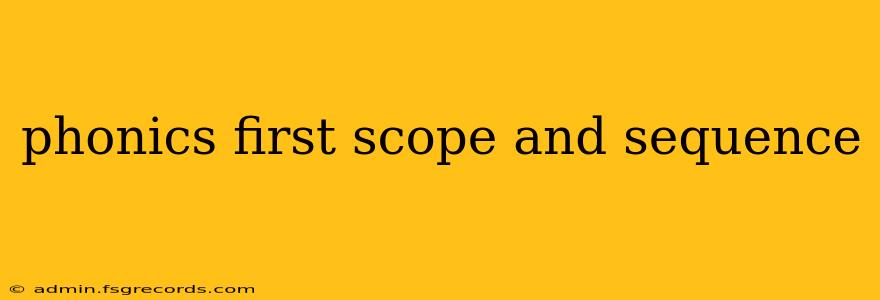The "Phonics First" approach to reading instruction prioritizes systematic and explicit phonics instruction as the foundation for reading acquisition. This approach emphasizes the relationship between letters and sounds, equipping students with the skills to decode words independently. A well-structured scope and sequence is crucial for successful implementation. This guide provides a detailed overview of what a typical Phonics First scope and sequence might entail, covering key skills and their developmental progression. Remember, individual programs may vary slightly, so always refer to your specific curriculum materials for precise details.
Kindergarten: Building the Foundation
Kindergarten marks the crucial initial phase, laying the groundwork for future reading success. The focus is on developing phonemic awareness and introducing basic letter-sound relationships.
Key Skills Introduced in Kindergarten:
- Phonemic Awareness: Activities focusing on rhyming, identifying beginning and ending sounds, blending and segmenting sounds in words (e.g., cat = /c/-/a/-/t/).
- Alphabet Knowledge: Learning letter names and shapes, both uppercase and lowercase.
- Consonant Sounds: Introduction of common consonant sounds, starting with single consonants like /b/, /p/, /m/, /t/, /d/, /n/, /s/, /f/, /l/, etc.
- Short Vowel Sounds: Introduction of short vowel sounds (/a/, /e/, /i/, /o/, /u/) and their corresponding letter representations.
- High-Frequency Words: Introducing sight words (words that are frequently encountered but don't always follow phonetic rules) through repeated exposure and practice. Examples include "the," "a," "is," "to," etc.
- Blending CVC words: Combining consonant-vowel-consonant (CVC) sounds to read simple words like "cat," "dog," "sun."
First Grade: Expanding Decoding Skills
First grade builds upon the kindergarten foundation, introducing more complex phonetic elements and expanding vocabulary.
Key Skills Introduced in First Grade:
- Digraphs and Blends: Teaching consonant digraphs (two consonants making one sound, like "sh," "ch," "th") and consonant blends (two or more consonants blended together, like "bl," "st," "tr").
- Long Vowel Sounds: Introducing various ways to represent long vowel sounds (e.g., using silent "e," vowel teams like "ea," "ai," "oe").
- R-Controlled Vowels: Teaching the unique sounds vowels make when followed by the letter "r" (e.g., "ar," "er," "ir," "or," "ur").
- Diphthongs: Introducing diphthongs (two vowel sounds blended together, like "oi," "oy," "ow").
- Advanced CVC words: Working with more complex CVC words and variations.
- Multisyllabic words: Beginning to break down multisyllabic words into smaller, manageable parts.
- Advanced Sight Words: Expanding the sight word vocabulary with more complex and frequently used words.
Second Grade and Beyond: Fluency and Comprehension
By second grade and beyond, the focus shifts from foundational decoding skills towards fluency and comprehension. While phonics instruction continues, it’s integrated with other reading skills.
Key Skills Developed in Later Grades:
- Advanced Phonics Patterns: Continued exploration of less common vowel patterns and spellings.
- Etymology: Introduction of word origins and how understanding roots and affixes helps decode meaning.
- Syllabication: Developing mastery of multisyllabic word decoding.
- Reading Fluency: Practicing reading with speed, accuracy, and expression.
- Vocabulary Development: Expanding vocabulary through reading and explicit vocabulary instruction.
- Reading Comprehension: Developing the ability to understand and interpret text.
Adapting the Scope and Sequence: Differentiated Instruction
It's crucial to remember that a Phonics First scope and sequence should be adaptable to individual student needs. Differentiated instruction is essential. Some students may progress faster, requiring enrichment activities, while others may need more time and support on specific skills. Regular assessment is key to monitoring progress and adjusting instruction accordingly.
Conclusion: The Importance of a Strong Phonics Foundation
A well-defined and systematically implemented Phonics First scope and sequence provides a strong foundation for reading success. By focusing on explicit and systematic phonics instruction, educators can empower students to become confident and independent readers, prepared for academic success. Consistent implementation and ongoing assessment are key to ensuring that students master these crucial skills at each stage of their development.

